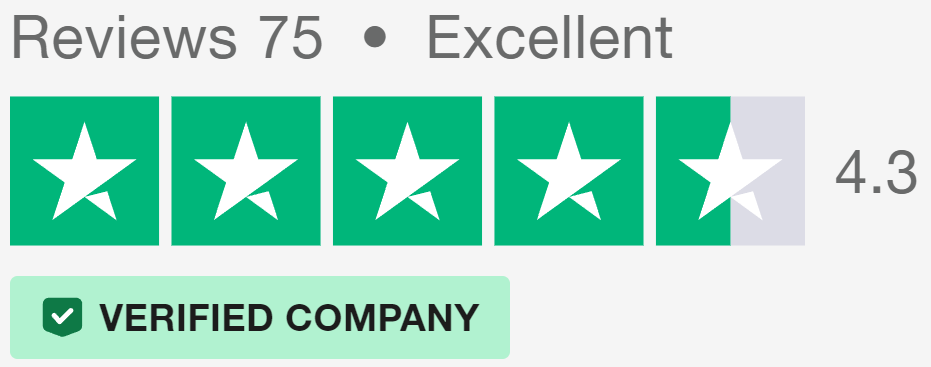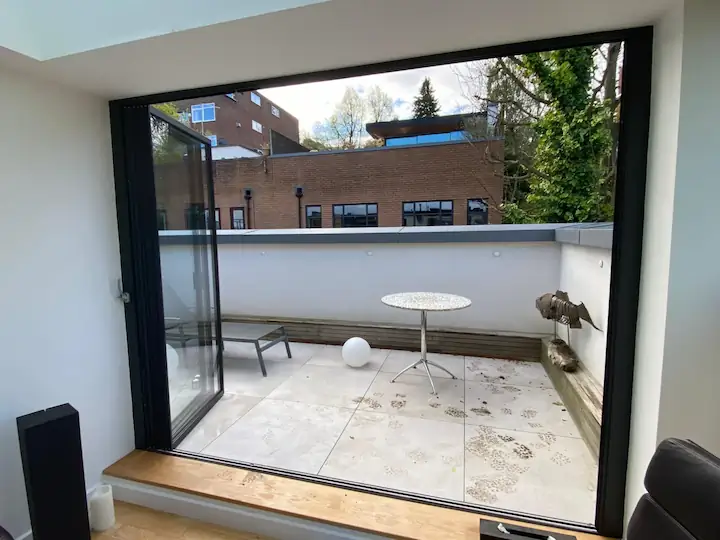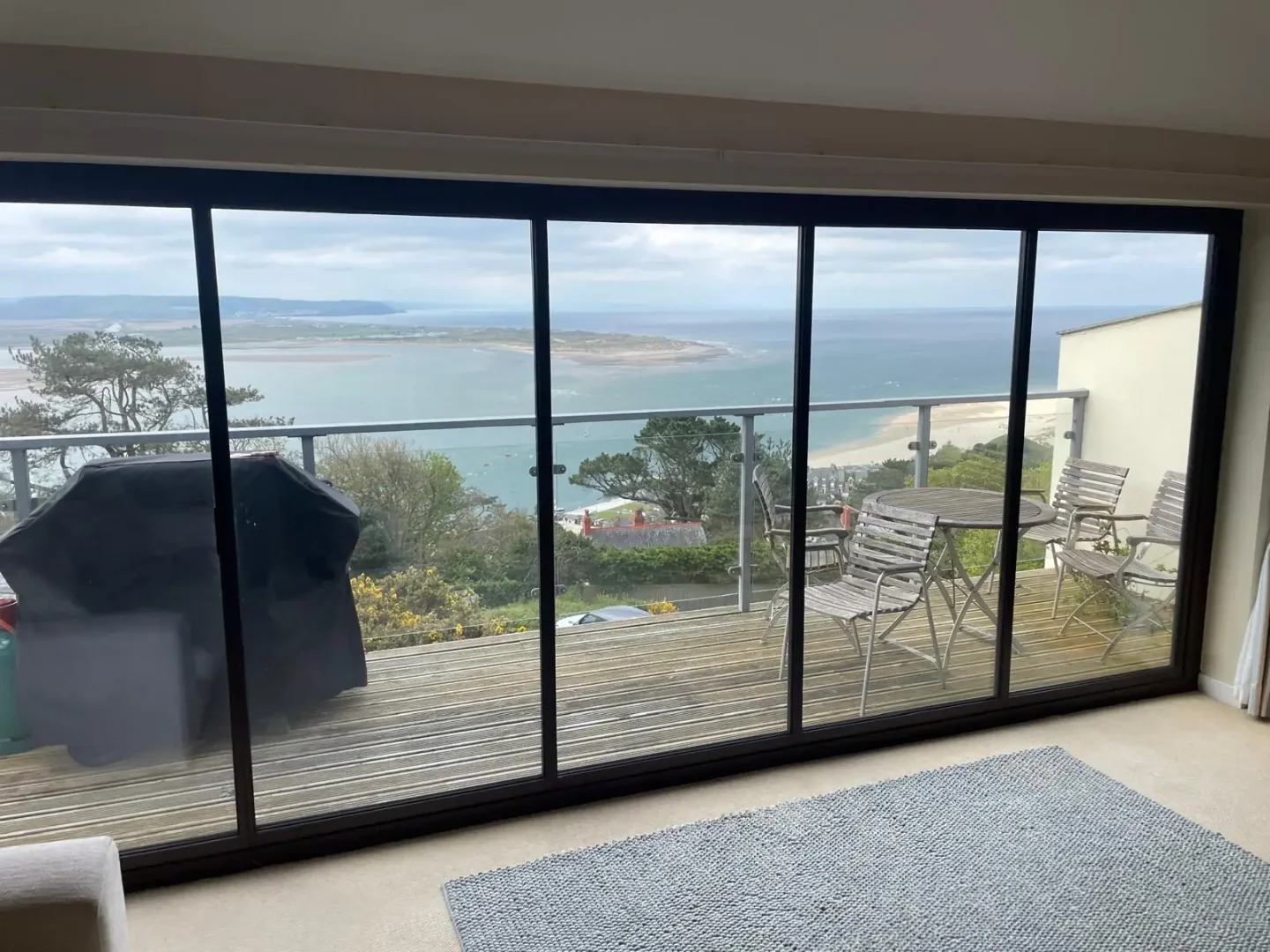Modern Concertina Doors: Choosing the Right System
Table of Contents

The Evolution of Modern Concertina Doors
Modern concertina doors have come a long way since their earliest iterations in post-war British architecture. The basic principle of concertina doors – panels that fold and stack – remains unchanged, but nearly every other aspect has been refined over decades of technical progress.
From Post-War Design to Present Day
British architects first adopted concertina doors, also known as bifold doors, in the 1950s. Early models featured basic aluminium frames with single-pane glass, primarily serving as room dividers in commercial spaces. The 1970s saw these systems move into residential settings, though they often struggled with weather resistance and smooth operation. By the 1990s, improved manufacturing techniques led to more stable designs, setting the foundation for today’s sophisticated modern concertina doors.

Key Design Changes
Modern concertina glass doors now feature components that largely eliminate the issues that plagued older systems. Advanced gaskets and weather seals have replaced the rubber strips of previous decades. Contemporary powder coated aluminium doors offer superior durability compared to their predecessors, withstanding British weather while maintaining their appearance year after year.
The running gear in current systems marks perhaps the biggest leap forward. Gone are the days of stiff rollers and temperamental tracks. Modern bottom-running systems use self-levelling wheels and advanced bearings that practically glide along their tracks. Top-hung designs have become lighter and more precise, supporting larger glass panels without putting extra strain on the frame above.
Materials Over Time
The shift from basic materials to advanced composites has redefined what’s possible with folding door systems. Early aluminium frames often conducted heat poorly and suffered from condensation. Current thermal break technology creates a barrier between inner and outer surfaces, while multi-chambered profiles boost insulation values. Glass technology has advanced too: modern units combine multiple layers with specialist coatings and gas-filled cavities to control heat and light.
How Modern Concertina Doors Work
Modern concertina doors operate on principles refined through decades of technical advancement. Their core mechanics centre on precision-made components working together to create reliable, easy-to-use systems that last.
Advanced Track Systems
Running gear quality determines how well modern concertina doors perform day-to-day. Bottom-running tracks use stainless steel channels with specially shaped grooves that guide each panel. These tracks feature built-in drainage ports that prevent water build-up and remove debris automatically. The wheels themselves contain sealed bearings similar to those found in high-performance bicycles, allowing panels weighing up to 100kg to move with just a light push.
Top-hung systems take a different approach. Rather than rolling along the bottom, the door panels hang from overhead tracks using carriages fitted with precision bearings. This design keeps the floor threshold clear and spreads the door’s weight across the head frame. Load-spreading plates distribute force evenly, preventing any single point from taking too much strain.
Each roller carriage contains multiple wheels arranged to handle vertical and lateral forces. Adjustable hinges let installers fine-tune how panels align, ensuring proper operation even if walls aren’t perfectly straight. Modern concertina glass doors use these advances to operate reliably despite the weight of large glass panels.
Thresholds
Floor levels posed a major challenge for older systems, but modern concertina doors now offer genuinely flat thresholds. Magnetic seals have replaced bulky rubber gaskets, while slim profile bifold doors use rebated tracks that sit almost flush with finished floor levels. When closed, these systems create an effective barrier against wind and rain without requiring a step-over threshold.
Low-profile guide channels work alongside drainage systems built into the frame itself. Water flows away through concealed channels rather than pooling around seals or seeping under doors. This hidden drainage prevents leaves and debris from blocking water escape routes while maintaining the clean lines that modern designs demand.
Modern Locking Mechanisms
Security features in modern concertina doors have moved well beyond basic hook bolts. Multi-point systems now lock panels together at several heights, while anti-lift devices prevent forced entry attempts. Shoot bolts extend into the head and track, securing the doors when closed or in their favourite ventilation positions.
Handle designs have improved too. Modern systems use ergonomic lever handles that need less force to operate than older D-handles. These connect to gearing mechanisms inside the frame, multiplying the user’s input force to move multiple lock points at once. Premium systems feature magnetic catches that hold panels in place when opened fully, preventing unwanted movement in breezy conditions.
Thermal Performance
Modern concertina doors tackle heat loss through advanced frame designs. Thermal breaks created from reinforced polyamide separate the inner and outer parts of each frame section. This barrier stops cold from transferring through metal frames while strengthening the overall structure. Multi-chamber profiles add extra insulation by trapping pockets of air within the frame sections.
Glass technology plays an equally important part. Double-glazed units now feature warm edge spacer bars that reduce heat loss around their edges. Special coatings on the glass itself reflect heat back into rooms during winter while limiting solar gain in summer. These improvements mean modern concertina doors perform as well as regular windows in terms of thermal efficiency, unlike their predecessors which often created cold spots in homes.
Designs and Layouts for Modern Concertina Doors
Modern concertina doors come in numerous configurations to suit different spaces and purposes. The right arrangement depends on factors like available wall space, desired opening width, and how you plan to use the space.
Popular Fold Patterns
Door panels typically fold in pairs, with configurations described by numbers; 3-3-0 means three panels folding each way, while 5-1-0 describes five panels folding one way with a single opening door. Larger openings might use modern concertina glass doors in a 4-4-0 pattern, creating a balanced look when closed while providing the widest possible opening. Smaller spaces often work better with asymmetric layouts like 3-1-0, where a main traffic door handles daily use.
The way panels stack makes a substantial difference to practicality. Modern concertina doors can fold completely clear of the opening, stacking either inside or outside. Glass kitchen doors, for example, often stack externally to maintain clear internal space for cabinets and appliances. The stack depth varies with panel width – wider panels create a deeper stack but require fewer panels overall.
Corner Systems
Corner arrangements remove the need for fixed posts, opening up entire room corners. These systems use special hinges and running gear to handle the added complexity of folding around corners. Modern concertina doors designed for corner use feature modified threshold sections that meet at perfect angles, preventing any gaps where the tracks intersect.
When closed, corner systems appear as two separate door sets meeting at right angles. Opening them reveals how the panels interlock – the first door must open before the second can move, creating a specific operation sequence. This design allows for impressive opening widths while maintaining stability in windy conditions.
Technical Requirements
Load-bearing calculations become more complex with corner installations. The roof structure above must adequately support the opening without the traditional corner post for strength. Steel support beams hidden within the ceiling typically provide this structural integrity.
Stack Options
External stacking arrangements place folded panels outside the building line. This setup works well for modern concertina doors installed across kitchen-garden boundaries, keeping interior spaces free from stacked panels. Specially designed weather covers protect external stacks from rain and debris without compromising the system’s appearance.
Internal stacking suits rooms where external stacking isn’t practical, such as upper floors or where outside space is limited. The panels fold inward, requiring careful planning of furniture placement. Many homeowners create dedicated niches beside the frame, turning the stack into a design feature rather than an obstruction.
Panel Proportions
Panel width-to-height ratios determine how stable a system remains over time. Taller panels need greater width to prevent warping, while very wide panels might strain their hinges. Most modern concertina doors use panels between 700mm and 1000mm wide, striking a balance between aesthetics and design limits. This sizing allows doors to open smoothly while looking proportional when closed.
Glass specifications change with panel size too. Larger panels require thicker glass units to resist wind pressure, which increases the importance of high-quality running gear. The latest systems compensate for these heavier panels with improved roller designs and stronger frame sections, maintaining easy operation despite the increased weight.
Internal Modern Concertina Doors
Internal spaces demand different approaches to door design than external openings. Modern concertina doors used inside homes need to balance privacy and flexibility while matching interior styling and allowing natural light flow between spaces.

Room Division Ideas
Living spaces work harder when walls can move. Modern internal concertina doors let rooms adapt to changing needs throughout the day. A dining room might open fully to the kitchen while entertaining, then close for quieter family meals. Home offices become guest bedrooms when needed, with full-width openings making furniture moves simpler.
Glass panels bring natural light deep into buildings, even when doors stay closed. Partially glazed options balance light flow with privacy, while bifold room dividers featuring obscured or decorative glass create subtle screening effects. Wooden panels suit period properties or spaces where complete privacy takes priority over light sharing.
Acoustic performance varies between systems. Basic dividers might reduce noise by 20 decibels, while premium modern concertina glass doors can match fixed walls for sound blocking. Multi-layer glass, specialist seals, and solid core panels all play their part in managing sound transmission. Some systems use double seals between panels, creating mini air gaps that absorb sound waves.
Replacing Regular Doors
Swapping hinged doors for modern concertina doors requires careful planning but opens up numerous layout possibilities. Standard door openings need widening to accommodate multiple panels, though slim-profile systems can sometimes fit existing spaces. Head frames distribute weight differently than traditional door frames, often needing additional structural support.
Track options change with door weight and available head height. Top-hung systems work well where floor levels vary slightly, while bottom-running tracks suit situations with strong ceiling joists. Some modern internal concertina doors combine top and bottom running gear, spreading the load evenly while ensuring reliable operation.
Matching Interior Design
Frame finishes for internal use go beyond standard white paint. Wood veneers, laminates, and specialist coatings let modern concertina doors match or contrast with interior schemes. Some manufacturers offer dual finishes, allowing different colours or materials on each room side. This flexibility helps doors complement separate colour schemes in adjoining spaces.
Hardware choices influence how well systems fit their surroundings. Flush handles reduce visual intrusion when doors stand open, while matching metal finishes to existing ironmongery creates visual coherence. Premium systems offer concealed hinges and runners, presenting clean lines whether open or closed.
Problems Solved by New Technology
Modern concertina doors have overcome many limitations that made older systems frustrating to use. Advanced materials and refined designs tackle previous issues while adding new capabilities that simply weren’t possible with earlier technology.

Weather Protection
Older folding door systems often leaked during heavy rain, letting water seep through gaps between panels and around frames. Modern concertina doors use compression seals that press firmly together when closed, creating reliable barriers against wind and rain. Multi-point locking systems pull panels tight against these seals, maintaining consistent pressure across the entire door width.
Water management has improved substantially too. Current drainage systems channel any water that reaches the frame through hidden paths to the outside, preventing it from pooling around seals or tracking across thresholds. One of the benefits of bifold doors are their sophisticated threshold designs, which combine effective water barriers with low step-over heights.
Modern concertina glass doors employ multiple layers of protection against the elements. Primary seals stop most water and air movement, while secondary barriers catch anything that makes it past the first line of defence. Brush seals along the bottom of each panel sweep tracks clean during operation, preventing debris from interfering with drainage channels.
Smooth Running
Operational issues plagued many older systems, with doors becoming harder to move over time. Current designs use self-lubricating bearings and wear-resistant materials in all moving parts. Running gear features built-in adjustment points, letting installers fine-tune panel alignment without dismantling components. These adjustments compensate for natural building movement that might otherwise cause sticking or binding.
Track designs prevent common problems like wheels jumping their guides. Deeper channels keep rollers properly aligned, while anti-lift mechanisms stop panels from being forced out of their tracks. Some modern concertina doors now include automatic panel alignment systems that guide each section into its correct position when closing.
Temperature Control
Heat loss through older folding doors created cold spots in rooms and high heating bills. Current thermal break technology splits frames into separate inner and outer sections, limiting heat transfer through the metal. Multi-chamber designs trap additional air pockets within frame sections, improving insulation values beyond what simple thermal breaks can achieve.
Glass technology has advanced considerably since early double-glazing. Modern units combine multiple layers with special coatings that reflect heat back into rooms. Gas-filled cavities between panes reduce heat transfer, while warm-edge spacers limit thermal bridging around glass edges. These improvements mean current systems perform similarly to fixed windows in terms of heat retention.
Security Improvements
Break-ins through older folding doors often exploited weak points in locking systems or poor-quality materials. Current designs use multi-point locks that secure panels at several heights, making forced entry much more difficult. Lock cylinders meet the latest security standards, resisting picking and drilling attempts that might have defeated older mechanisms.
Frame strength has improved through better material choices and manufacturing methods. Reinforced corners prevent frames from being twisted apart, while toughened aluminium sections resist attempts to bend or break components. Modern concertina doors include these security features without adding obvious bulk to their profiles, maintaining clean sight lines while providing proper protection.
Panel Stability
Warping and bowing caused problems in earlier systems, particularly with wider panels. Current manufacturing techniques produce more stable components that maintain their shape over time. Frame sections include internal reinforcement where needed, preventing the gradual distortion that once made doors harder to operate as they aged.
Operation in Different Weather
Temperature changes caused binding and sticking in older systems as materials expanded and contracted. Modern concertina doors use materials chosen for their stability across wide temperature ranges. Thermal expansion gaps built into frames and tracks accommodate natural movement without compromising operation or weather protection.
Maintenance Requirements
Older systems needed regular adjustment and lubrication to keep working properly. Current designs use components that need minimal maintenance, with self-cleaning tracks and corrosion-resistant materials throughout. When parts do need attention, modular construction makes repairs simpler without requiring complete system replacement.
We’d Love to Help You
Vision Glass Doors is a designer, manufacturer, and installer of premium door systems. We are a family run business with over 20 years’ experience and 5,000 installations across the UK.
Our leading range of door systems include Ultra Slim – Slide and Turn Doors, Slimline Sliding Patio Doors and Frameless Glass Doors. Suitable for various internal and external applications, they are applicable to residential and commercial projects.
Click Quick Quote Online for a free quotation within 24 hours. Alternatively, call or email us on 01582 492730 or at info@visionglassdoors.co.uk.

